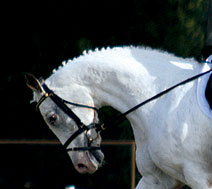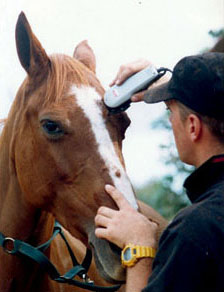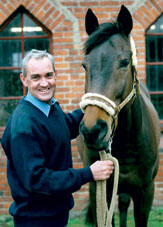|
Overshadowing
by Dr Andrew and Manuela McLean
Australian Equine Behaviour Centre
Overshadowing can be defined as the effect of two signals of different intensity being applied together, so that only the most intense will result in one learned response, while the response normally obtained by the perceived weaker signal diminishes.
Overshadowing can be used as a training tool when it comes to eliminating the fearful responses that horses often exhibit in day to day management tasks, such as clipping and receiving medication.
When the horse is ridden the leg aids are used as the foundation signals for acceleration - upward transitions, lengthening the stride and increases in activity - as well as for lateral movements. Similarly the bit, via the reins, provides the foundation signals for deceleration - downward transitions, backward steps, shortening and slowing within the gait - as well as turning the forequarters. The horse’s responses to the leg and rein aids are learned through operant conditioning, where the horse has been trained to respond through negative reinforcement - the ceasing of something considered unpleasant when the horse responds, as in the removal of the leg aid when it moves away from this. Once the aids are light then positive reinforcement - the addition of a pleasant stimulus - helps in the maintenance of the behaviour. Upon this base of training other more subtle cues, such as seat and positional aids, can be added through the process of classical conditioning. This is how a horse makes an association with a particular aid to a behaviour or response and then the presence of that aid causes the response or behaviour to be repeated.
During foundation training of the horse, operant aids - those signals that the horse has been trained to respond to consistently through positive and negative reinforcement - are trained first; they require constant checking and refining in order to avoid behaviour problems from occurring. Although they still require polishing for optimum performance, classically conditioned aids - where learned responses are obtained from more subtle versions of the same signal or to entirely new signals - are more sympathetic and have less impact on behaviour problems.
OVERSHADOWING
One of the most common problems that arises in horse training is simultaneous aids for acceleration and deceleration responses. Applying aids for ‘go-forward’ at the same time as those for ‘stop-going-forward’ is ill-advised, not only because the muscles used in each response are opposing, but also because of problems arising from the simultaneous aids out-competing one another. Known as overshadowing, this is one of those interesting techniques that can be very detrimental to the training process when used inappropriately but when used correctly can be of great benefit.
Overshadowing can be defined as the effect of two signals of different intensity being applied together, so that only the most intense will result in the expression of one learned response while the response normally obtained by the perceived weaker signal diminishes. Importantly, this diminishing of the weaker signal is permanent so it is not merely a temporary distraction. Overshadowing was first described by Pavlov in 1927 and described later in greater detail by behavioural scientist Hull in 1952. It has been used by horse trainers for eons, however because it was never identified as a process or a training ‘tool’ in itself, it was limited to certain techniques used by good horsepeople.
Research has highlighted the fact that certain techniques already being used were overshadowing and could be expanded to leg-shyness, clipper-shyness, needle-shyness, wormer-shyness, cold-backed behaviour and many more. Overshadowing accounts for much of the detrimental effect of simultaneous rein and leg aids in modern training, the concept of ’riding the horse forward into a restraining hand‘ was very problematic if it involved using the aids for forward and the aids for stop simultaneously. The implications of overshadowing are that when the horse is faced with simultaneous rein and leg aids, it will choose to respond only to the most significant stimulus.

For overshadowing to be an effective desensitising tool, the step-forward and the step-back responses ( or the head-down /head-up responses for milder adversive stimuli) should be trained to be elicited repeatedly, without delay from one to the other and from absolutely light aids. From light aids you should be able to step the right leg forward/back then forward/forward without delay and then the same with the left foreleg. Photographs courtesy of Australian Equine Behaviour Centre.
BIT PRESSURE AVOIDANCE
In terms of aversiveness or avoidance, pressures in the horse’s mouth (via the reins) would, in most circumstances, be expected to be of greater significance than those on the sides (provided by the rider’s legs). In this way, the bit pressures would overshadow the leg pressures and the result is that the horse becomes less responsive to the rider’s leg signals. It is clear now why the aids need to be separated, if only by a short time frame. Like the spoken word, aids can be fast, but if they are all heaped into one moment, meaning is lost. This overshadowing problem provides the mostly likely explanation for the phenomena of ‘dead sides’, ‘laziness’ and ‘heavy mouths’ in performance horses and partially explains why so many horses need to be ridden with spurs and harsh bits.

Horses can quickly become dull to the aids with the rider’s use of
simultaneous leg and rein aids or the non release of pressure when the horse responds,
such as a heavy contact being maintained after a downward transition.
However, overshadowing of the aids is common and even encouraged in many equestrian methods. Even Xenophon, the Greek scholar from 431 BC considered by many to be the father of sympathetic horsemanship, encouraged overshadowing, “If you support him by the bit and at the same moment give him one of the signs to dash forward, the bit holds him in and the signal to advance rouses him up. He will then throw out his chest and raise his legs rather high, and furiously though not flexibly, for horses do not use their legs very flexibly when being hurt”.
Since then, using both rein and rider’s leg signals have been advocated by ‘great masters’ such as Baucher (1796-1873) and more recently in the German National Equestrian Federation Handbook. The latter is considered the most influential current training method as a result of modern German dominance of Olympic medals in equestrian sports. And while, superficially, it may seem that the methodology of a nation as successful in international competitions as Germany must be theoretically correct, competition success is not necessarily the best way to judge the welfare status or ’horse sense’ of a training system.
Training Associated Behavioural Problems
Significant problems in the popular modern training styles of performance horses are implied by alarmingly high slaughter statistics. Researchers Ödberg and Bouissou reported in 1999 that 66.4% of non-racing horses sent to abattoirs between the ages of two and seven years were sent there for behaviour reasons. A German study suggested similar findings. Ethological and Veterinary journals report that conflict behaviours such as bucking, rearing, shying, bolting, aggression and hyper-reactive behaviours (tension) are frequently associated with modern training methods. Research also suggests that reduced responses to the aids, chronic stress and learned helplessness - a coping mechanism where animals or humans learns to remain passive and compliant in order to survive difficult or abusive circumstances - may also arise from impossible or confusing demands from riders such as the simultaneous use of the rider’s legs and reins.
Interestingly, in his later years the nineteenth century, trainer Baucher renounced the simultaneous use of the rider’s reins and legs and coined the classical equestrian maxim “reins without legs and legs without reins”. These days, classical dressage exponents distance themselves from the contemporary approach by maintaining such maxims.
Working with elephants in Asia has striking similarities with horse training. In India people asked, “why do elephants kill the mahouts that love them?” Love isn’t enough unfortunately - if the pressure (a euphemism for pain) is relentless and confusing, elephants, like stallions will turn on their handler, or the person causing the pressure. Horses generally however are so much more oriented towards defence that they mostly tend to express their distress by running away.
Overshadowing however, is not always detrimental to the horse. There are some benefits when it comes to eliminating the fearful responses that horses often exhibit in day to day management tasks such as clipping and receiving medication. This can be achieved by overshadowing the particular anxiety response through simultaneous requests of certain mobility responses.

Overshadowing can modify and eliminate
fearful responses,
such as clipping, that can develop from a
single event and go on to affect many day to day tasks.
Optimally, the process should be undertaken gradually, beginning at the lowest threshold of anxiety. Because overshadowing results in the waning or lessening of one response in favour of another, it is common for powerful stimuli that causes fear in the horse to overshadow the handler’s in-hand signals of forward and stop, so the horse simply runs away to greater or lesser extent. Therefore, if the situation is reversed, so that the handler’s in-hand signals are more deeply trained to the extent that they overshadow the fearful responses of the horse, the undesirable, fearful responses will become less as the horse becomes habituated to the originally fearful stimulus (e.g. the clippers). In other words, if the horse is stepped forward and back by the handler while the fearful stimulus is maintained at a distance where it is only mildly fearful. In severe cases a bit in the horse’s mouth (such as a rearing bit) gives the handler better effect. As the horse is stepped forward and back (or just back) the amount of pressure required to do so becomes lighter and lighter. This coincides with the diminution of the fear response to the fearful object.
The correct approach in using overshadowing is to begin with the lowest levels of fear, then the fearful object is brought closer again until the horse shows some mild fear and once again the step back and forward procedure is used till the response comes from light aids. Very soon the clippers or injection makes contact with the horse’s skin and once again the procedure is repeated till lightness of the aid occurs. When the horse is not extremely fearful the head down response can be used in overshadowing.
Habitual Responses
Horses require very few experiences with fearful behaviours for them to become habitually practiced, and many chronic fearful responses in both humans and animals can be traced back to a single event. When working with fearful responses, it is important to consider their rapid acquisition and persistence. Fear responses are typically expressed as rapid forward moving responses, therefore training the horse to step back in hand can provide a useful tool in overshadowing where the horse is stepped back while overshadowing him to something to which he shows tension or fear. Training the horse to step back in-hand can be done by tapping the chest or cannon bones with the dressage whip until the horse does so. The whip should not be used harshly but only as a rhythmic tapping which increases in speed but not intensity. When coupled with a rein aid, this reinforces a light rein response.
Importantly it has been demonstrated in animals that, preventing the expression of fear makes it easier to habituate (diminish the physiological or emotional response) of the animal to fearful stimuli such as clippers or needles. Thus, overshadowing offers the most efficient way to modify fear responses because of its inherent locomotory control and subsequent prevention of fearful and rewarding fleeing responses.
Because of their effectiveness, overshadowing procedures now form the Australian Equine Behaviour Centre’s predominant treatment protocol for fearful horses requiring de-sensitisation.
 About The Authors About The Authors
Dr Andrew and Manuela McLean have a mix of academic knowledge and equestrian achievements. Andrew, a zoologist, has represented Australia in Horse Trials and competed to FEI level in dressage.
Manuela, a biologist with Animal Behaviour qualifications, has trained horses to FEI level in dressage and Advanced 3DE.
Together they have developed the internationally recognised Australian Equine Behavioural Centre (AEBC) in Broadford, Victoria.
Web: www.aebc.com.au
Andrew is a presenter at Equitana Melbourne, from the 18th to the 21st November 2010, at the Melbourne Showgrounds.
www.equitana.com.au. |